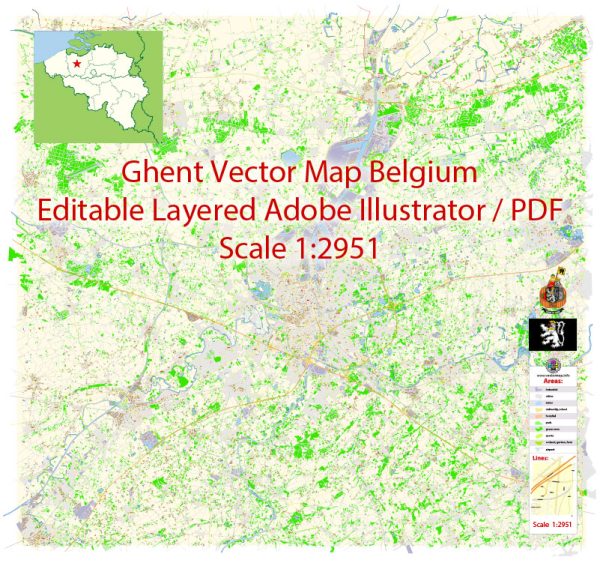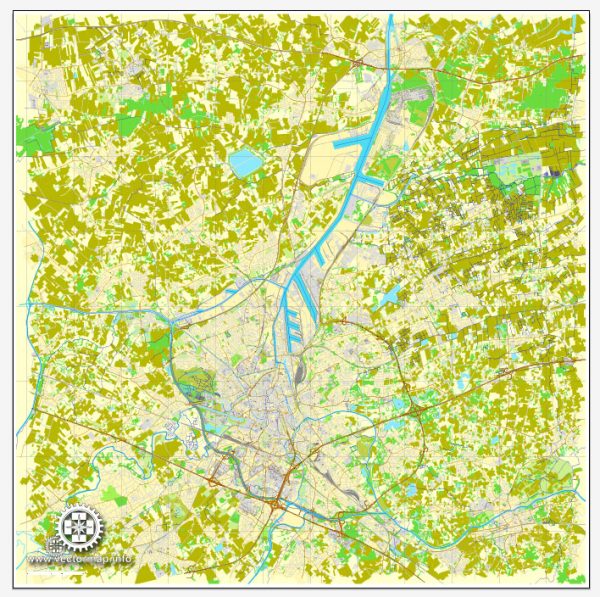Geographic Description of Ghent, Belgium
Ghent, a vibrant city in the Flanders region of Belgium, is located at the confluence of two rivers: the Scheldt (Schelde) and the Lys (Leie). This strategic position made Ghent an important trade hub throughout history. The city is approximately 50 kilometers (31 miles) northwest of Brussels, 60 kilometers (37 miles) southwest of Antwerp, and 50 kilometers (31 miles) southeast of Bruges, placing it at the heart of the Flemish region.
Key Features:
- Waterways and Canals:
- Ghent is crisscrossed by a network of canals, which give it a picturesque charm. Key waterways include the Coupure Canal and the Gent-Terneuzen Canal, which connects the city to the North Sea, enhancing its historic role as a port city.
- The rivers Scheldt and Lys are prominent, meeting near the historic center.
- Topography:
- The city lies in a relatively flat area with low-lying plains, typical of Flanders, and is surrounded by fertile agricultural lands.
- Urban Layout:
- The historic core of Ghent is compact and pedestrian-friendly, marked by medieval architecture, narrow cobbled streets, and historic squares like Korenmarkt and Vrijdagmarkt.
- Modern suburban areas extend outward, creating a blend of historic and contemporary neighborhoods.
- Cultural Landmarks:
- Iconic structures such as the Gravensteen Castle, Saint Bavo’s Cathedral, and the Belfry of Ghent define the cityscape.
- The university and research institutions contribute to Ghent’s dynamic and youthful atmosphere.
- Climate:
- Ghent has an oceanic climate, with mild summers and cool, damp winters. Rainfall is fairly evenly distributed throughout the year.
Brief History of Ghent
Early History:
- Ghent’s history dates back to Roman times, when it was a small settlement known as “Ganda.” Its location at the river confluence made it suitable for early habitation.
- By the 7th century, the area became a center of Christianity, with Saint Amand founding the Abbey of Saint Bavo and the Abbey of Saint Peter.
Medieval Period (Golden Age):
- Between the 11th and 15th centuries, Ghent flourished as one of the largest and wealthiest cities in Europe, thanks to its textile industry. It was especially known for producing high-quality woolen goods.
- The city gained significant autonomy during this period and was a hub for commerce, attracting traders from across Europe.
- Notable constructions from this era include the Gravensteen Castle (1180) and Saint Nicholas’ Church.
Renaissance and Decline:
- The 16th century brought challenges, including the Protestant Reformation and political conflicts under Spanish rule. Ghent was involved in resistance movements but eventually suffered economically and politically.
- The city lost prominence as Antwerp rose in significance.
Industrial Revolution:
- In the 19th century, Ghent regained its importance with the advent of industrialization, becoming a leading center for textile manufacturing again.
- The 1913 World Expo showcased Ghent on the global stage.
Modern Era:
- Today, Ghent is celebrated for its preservation of medieval heritage combined with a lively cultural scene, including festivals like the Ghent Festival (Gentse Feesten).
- Its universities and research facilities position it as an intellectual and cultural hub within Belgium.
Ghent balances its rich history with modern innovation, making it a city of historical depth and contemporary vibrancy.
Ghent, a city in Belgium, has a network of streets and roads that contribute to its unique charm. The city center is known for its well-preserved medieval architecture and is easily navigable on foot. Here are some of the principal streets and roads in Ghent:
- Graslei and Korenlei: These are two picturesque streets running along the banks of the River Lys (Leie). They are lined with medieval guildhalls and are considered among the most beautiful streets in Ghent.
- Veldstraat: One of the main shopping streets in Ghent, Veldstraat is bustling with shops, boutiques, and cafes. It’s a pedestrian-friendly street, making it a popular destination for shoppers.
- Sint-Michielsbrug: This is a bridge that provides a great view of the Graslei and Korenlei, as well as the medieval skyline of Ghent.
- Korenmarkt: This is the main square in the city center, surrounded by historic buildings, restaurants, and cafes. It’s a hub of activity and a central point for many events and festivals.
- Belfry of Ghent: Although not a street, the Belfry is a prominent landmark and tower in the city center. It offers panoramic views of Ghent and the surrounding areas.
- Sint-Baafsplein: This square is home to St. Bavo’s Cathedral and the famous Ghent Altarpiece. The cathedral and the square are central to the city’s history and architecture.
- Emile Braunplein: A square named after the former mayor of Ghent, Emile Braun. It is surrounded by historical buildings, including the Opera House and the City Hall.
- Coupure Links and Coupure Rechts: These are two streets that run along a canal, offering a charming atmosphere with trees, cafes, and old buildings.
- Jan Breydelstraat: This street connects the city center to the train station and is lined with shops and businesses.
- Gent-Zeehaven: This is the industrial port area of Ghent, where you’ll find a different aspect of the city with its harbors and industrial infrastructure.
Keep in mind that Ghent has an extensive network of smaller streets, alleys, and canals that add to the city’s character. Exploring the city on foot or by bike is a great way to discover hidden gems and enjoy the historic atmosphere.



 Author: Kirill Shrayber, Ph.D.
Author: Kirill Shrayber, Ph.D.